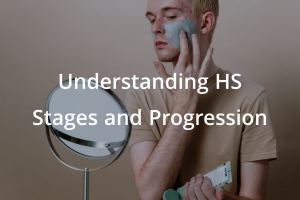
Understanding HS Stages and Progression
Hidradenitis Suppurativa (HS) is a chronic, inflammatory skin condition characterized by recurrent, painful nodules and abscesses. Understanding the stages of HS is crucial for effective management and treatment. Each stage of HS presents its challenges and requires specific therapeutic approaches tailored to the severity of the disease. As a board-certified plastic surgeon focusing on treating complex skin conditions, Dr. Som can provide a detailed breakdown of the stages of HS, how the condition progresses, and the available treatment options at each stage. This comprehensive understanding can help patients and their families navigate the complexities of HS more effectively.
Stages of Hidradenitis Suppurativa
Stage 1: Mild HS (Hurley Stage I)
- Description: This initial stage is characterized by the presence of abscesses without sinus tracts or scarring. The lesions may be single or multiple but are typically confined to one area.
- Treatment Options: Treatment at this stage often involves lifestyle modifications such as weight management and smoking cessation. Medical treatments include topical therapies (antibiotics and resorcinol) and intralesional corticosteroids. Early intervention can help prevent progression to more severe stages.
Stage 2: Moderate HS (Hurley Stage II)
- Description: At this stage, patients experience recurrent abscesses, tract formation and scarring, which may be widespread across a region. Painful, tunnel-like formations may also form under the skin.
- Treatment Options: Treatment for Stage II HS typically involves systemic medications such as oral antibiotics, hormonal therapies (for those who respond), and TNF-alpha inhibitors, which can be quite effective in reducing inflammation and preventing further progression. Pain management and wound care are also critical at this stage.
Stage 3: Severe HS (Hurley Stage III)
- Description: The most advanced stage of HS includes multiple interconnected sinus tracts and abscesses across a wide area, often with significant scarring. Mobility may be impacted, and chronic pain can be a major issue.
- Treatment Options: At this stage, advanced treatments such as biologics (e.g., adalimumab, the first FDA-approved medication for HS), systemic corticosteroids, and sometimes surgery to remove extensive areas of affected tissue are considered. Surgical options may include wide excision of the affected areas to reduce the disease burden and improve quality of life.
Managing Progression
- Early Detection: Early diagnosis and treatment are key to managing HS effectively. Recognizing symptoms early and consulting with a healthcare provider can prevent the condition from worsening.
- Regular Monitoring: Regular follow-ups with a dermatologist or specialized surgeon are essential to monitor the condition, assess treatment efficacy, and make necessary adjustments. Imaging studies may occasionally be required to evaluate the extent of sinus tract formation.
- Holistic Management: Managing HS often requires a comprehensive approach, including pain management, psychological support, and patient education about skin care. Support groups and counseling can also be beneficial in helping patients cope with the social and emotional challenges of HS.
Conclusion
Hidradenitis Suppurativa is a progressively debilitating condition that demands a nuanced understanding of its stages for effective management. By familiarizing themselves with the stages of HS and the corresponding treatment options, patients can actively participate in their treatment planning. At the Beverly Hills Hidradenitis Clinic, we are dedicated to providing personalized care that addresses the physical and emotional aspects of living with HS. If you or someone you know is struggling with symptoms of HS, early consultation and intervention are crucial steps toward managing this challenging condition and improving overall quality of life.
